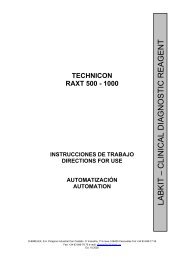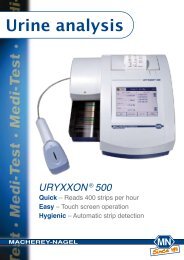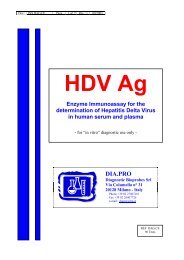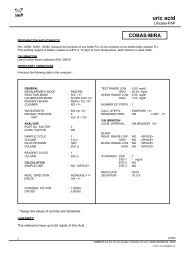HDV IgM - Agentúra Harmony vos
HDV IgM - Agentúra Harmony vos
HDV IgM - Agentúra Harmony vos
You also want an ePaper? Increase the reach of your titles
YUMPU automatically turns print PDFs into web optimized ePapers that Google loves.
Doc.: INS DIM.CE Page 1 of 7 Rev.: 2 06/2006<strong>HDV</strong> <strong>IgM</strong>“Capture” Enzyme ImmunoAssay(ELISA) for the determination of <strong>IgM</strong>antibodies to Hepatitis Delta Virusin human plasma and sera- for “in vitro” diagnostic use only -DIA.PRODiagnostic Bioprobes SrlVia Columella n° 3120128 Milano - ItalyPhone +39 02 27007161Fax +39 02 26007726e-mail: diapro@tin.itREF DIM.CE96 Tests
Doc.: INS DIM.CE Page 2 of 7 Rev.: 2 06/2006<strong>HDV</strong> <strong>IgM</strong>A. INTENDED USEEnzyme ImmunoAssay (ELISA) for the determination of<strong>IgM</strong> class antibodies to Hepatitis Delta Virus or <strong>HDV</strong> in humanplasma and sera with the "capture" system. The kit is intendedfor the classification of the viral infective agent and the follow-upof <strong>HDV</strong> infected patients.For “in vitro” diagnostic use only.B. INTRODUCTIONThe Hepatitis Delta Virus or <strong>HDV</strong> is a RNA defective viruscomposed of a core presenting the delta-specific antigen,encapsulated by HBsAg, that requires the helper function ofHBV to support its replication.Infection by <strong>HDV</strong> occurs in the presence of acute or chronicHBV infection. When acute delta and acute HBV simultaneouslyoccur, the illness becomes severe and clinical and biochemicalfeatures may be indistinguishable from those of HBV infectionalone. In contrast, a patient with chronic HBV infection cansupport <strong>HDV</strong> replication indefinitely, usually with a less severeillness appearing as a clinical exacerbation.The determination of <strong>HDV</strong> specific serological markers (<strong>HDV</strong>Ag, <strong>HDV</strong> <strong>IgM</strong> and <strong>HDV</strong> IgG) represents in these cases animportant tool to the clinician for the classification of theetiological agent, for the follow up of infected patients and theirtreatment.The detection of <strong>HDV</strong> <strong>IgM</strong> and IgG antibodies allows theclassification of the illness and the monitoring of theseroconversion event.C. PRINCIPLE OF THE TESTMicroplates are coated with a monoclonal anti-h<strong>IgM</strong> antibodythat in the 1 stincubation “captures” specifically this class ofantibodies.After washing out all the other components of the sample, in the2 nd incubation bound anti <strong>HDV</strong> <strong>IgM</strong> are detected by the additionof recombinant <strong>HDV</strong> antigen immunocomplexed with a specificantibody, labeled with peroxidase (HRP).After washing, the enzyme captured on the solid phase, actingon the substrate/chromogen mixture, generates an optical signalthat is proportional to the amount of <strong>IgM</strong> antibodies present inthe sample.D. COMPONENTSEach kit contains sufficient reagents to carry out 96 tests.1. Microplate: MICROPLATE12 strips of 8 breakwells coated with purified anti human <strong>IgM</strong>specific mouse monoclonal antibody and sealed into a bag withdesiccant. Allow the microplate to reach room temperaturebefore opening; reseal unused strips in the bag with desiccantand store at 4°C.2. Negative Control: CONTROL -1x2.0 ml/vial. Ready to use. It contains, human antibodiesnegative to <strong>HDV</strong>, 3% skimmed milk, 0.2M Tris buffer pH 6.0+/-0.1, 0.2% Tween 20, 0.09% Na azide and 0.1% Kathon GC aspreservatives.The Negative Control is pale yellow color coded.3. Positive Control: CONTROL +1x2.0 ml/vial. Ready to use. It contains, human <strong>IgM</strong> antibodiespositive to <strong>HDV</strong>, 3% skimmed milk, 0.2M Tris buffer pH 6.0+/-0.1, 0.2% Tween 20, 0.09% Na azide and 0.1% Kathon GC aspreservatives.The Positive Control is green yellow color coded.Important Note: Even if this material has been chemicallyinactivated, handle as potentially infectious.4. Calibrator: CAL ….n° 1 vial. Lyophilized reagent to be dissolved with EIA gradewater as reported in the label. It contains fetal bovine serum,human <strong>IgM</strong> antibodies to <strong>HDV</strong>, 0.2 mg/ml gentamicine sulphateand 0.1% Kathon GC as preservatives.Important Notes:1. The volume necessary to dissolve the content of the vialmay vary from lot to lot. Please use the right volumereported on the label .2. Even if this material has been chemically inactivated,handle as potentially infectious.5. Wash buffer concentrate: WASHBUF 20X1x60ml/bottle. 20x concentrated solution.Once diluted, the wash solution contains 10 mM phosphatebuffer pH 7.0+/-0.2, 0.05% Tween 20 and 0.1% Kathon GC.6. Enzyme Conjugate 20X: CONJ 20X1x0.8 ml/vial. 20X concentrated solution. It contains peroxidaselabeled polyclonal antibody to <strong>HDV</strong>. The reagent is dissolvedinto a buffer solution 10 mM Tris buffer pH 6.8+/-0.1, 5% BSA,0.1% Kathon GC and 0.02% gentamicine sulphate aspreservatives.7. <strong>HDV</strong> Antigen: Ag <strong>HDV</strong>1x6 vials. Lyophilized reagent to be dissolved with 1.9 ml properdiluent. It contains non infective recombinant <strong>HDV</strong> Antigen, 25mM Tris buffer pH 7.8+/-0.1 and 5% human serum proteins.8. <strong>HDV</strong> Antigen Diluent: Ag DIL1x16 ml/vial. Buffered solution for the dissolution of thelyophilized <strong>HDV</strong> antigen. It contains 0.2 M Tris buffer pH 6.0+/-0.1, 0.1% Kathon GC and 0.2%Triton X100. The component isred colour coded.9. Specimen Diluent: DILSPE2x60.0 ml/vial. Buffered solution for the dilution of samples; itcontains 0.2M Tris buffer pH 6.0+/-0.1, 0.2% Tween 20, 3%Skimmed milk, 0.1% Kathon GC and 0.09% sodium azide aspreservatives. The component is blue clour coded.10. Chromogen/Substrate: SUBS TMB1x16ml/vial. Contains a 50 mM citrate-phosphate bufferedsolution at pH 3.5-3.8, 0.03% tetra-methyl-benzidine or TMB,4% dimethylsulphoxide and 0.02% hydrogen peroxide of H2O2.Note: To be stored protected from light as sensitive tostrong illumination.11. Sulphuric Acid: H2SO4 O.3 M1x15ml/vial. Contains 0.3 M H2SO4 solution.Attention: Irritant (Xi R36/38; S2/26/30)12. Plate sealing foils n° 213. Package insert n° 1E. MATERIALS REQUIRED BUT NOT PROVIDED1. Calibrated Micropipettes in the range 10-1000 ul anddisposable plastic tips.2. EIA grade water (double distilled or deionised, charcoaltreated to remove oxidizing chemicals used asdisinfectants).3. Timer with 60 minute range or higher.4. Absorbent paper tissues.5. Calibrated ELISA microplate thermostatic incubator (dry orwet) set at +37°C.6. Calibrated ELISA microwell reader with 450nm (reading)and if possible with 620-630nm (blanking) filters.7. Calibrated ELISA microplate washer.8. Vortex or similar mixing tools.
Doc.: INS DIM.CE Page 3 of 7 Rev.: 2 06/2006F. WARNINGS AND PRECAUTIONS1. The kit has to be used by skilled and properly trainedtechnical personnel only, under the supervision of amedical doctor responsible of the laboratory.2. All the personnel involved in performing the assay have towear protective laboratory clothes, talc-free gloves andglasses. The use of any sharp (needles) or cutting (blades)devices should be avoided. All the personnel involvedshould be trained in biosafety procedures, asrecommended by the Center for Disease Control, Atlanta,U.S. and reported in the National Institute of Health’spublication: “Biosafety in Microbiological and BiomedicalLaboratories”, ed. 1984.3. All the personnel involved in sample handling should bevaccinated for HBV and HAV, for which vaccines areavailable, safe and effective.4. The laboratory environment should be controlled so as toavoid contaminants such as dust or air-born microbialagents, when opening kit vials and microplates and whenperforming the test. Protect the Chromogen/Substrate(TMB/H2O2) from strong light and avoid vibration of thebench surface where the test is undertaken.5. Upon receipt, store the kit at +2..8°C into a te mperaturecontrolled refrigerator or cold room.6. Do not interchange components between different lots ofthe kits. It is recommended that components between twokits of the same lot should not be interchanged.7. Check that the reagents are clear and do not containvisible heavy particles or aggregates. If not, advise thelaboratory supervisor to initiate the necessary procedures.8. Avoid cross-contamination between serum/plasmasamples by using disposable tips and changing them aftereach sample.9. Avoid cross-contamination between kit reagents by usingdisposable tips and changing them between the use ofeach one.10. Do not use the kit after the expiration date stated onexternal (primary container) and internal (vials) labels.11. Treat all specimens as potentially infective. All humanserum specimens should be handled at Biosafety Level 2,as recommended by the Center for Disease Control,Atlanta, U.S. in compliance with what reported in theInstitutes of Health’s publication: “Biosafety inMicrobiological and Biomedical Laboratories”, ed. 1984.12. The use of disposable plastic labware is recommended inthe preparation of the washing solution or in transferringcomponents into other containers of automatedworkstations, in order to avoid contamination.13. Waste produced during the use of the kit has to bediscarded in compliance with national directives and lawsconcerning laboratory waste of chemical and biologicalsubstances. In particular, liquid waste generated from thewashing procedure, from residuals of controls and fromsamples has to be treated as potentially infective materialand inactivated. Suggested procedures of inactivation aretreatment with a 10% final concentration of householdbleach for 16-18 hrs or heat inactivation by autoclave at121°C for 20 min..14. Accidental spills have to be adsorbed with paper tissuessoaked with household bleach and then with water.Tissues should then be discarded in proper containersdesignated for laboratory/hospital waste.15. The Sulphuric Acid is an irritant. In case of spills, wash thesurface with plenty of water.16. Other waste materials generated from the use of the kit(example: tips used for samples and controls, usedmicroplates) should be handled as potentially infective anddisposed according to national directives and lawsconcerning laboratory wastes.G. SPECIMEN: PREPARATION AND RECOMMANDATIONS1. Blood is drawn aseptically by venepuncture and plasma orserum is prepared using standard techniques of preparationof samples for clinical laboratory analysis. No influencehas been observed in the preparation of the sample withcitrate, EDTA and heparin.2. Avoid any addition of preservatives to samples; especiallysodium azide as this chemical would affect the enzymaticactivity of the conjugate.3. Samples have to be clearly identified with codes or namesin order to avoid misinterpretation of results. When the kitis used for the screening of blood units, bar code labelingand electronic reading is strongly recommended.4. Haemolysed (red) and visibly hyperlipemic (“milky”) sampleshave to be discarded as they could generate false results.Samples containing residues of fibrin or heavy particles ormicrobial filaments and bodies should be discarded as theycould give rise to false results.5. Sera and plasma can be stored at +2°..8°C for up to fivedays after collection. For longer storage periods, samplescan be stored frozen at –20°C for several months. Anyfrozen samples should not be frozen/thawed more thanonce as this may generate particles that could affect the testresult.6. If particles are present, centrifuge at 2.000 rpm for 20 min orfilter using 0.2-0.8u filters to clean up the sample for testing.H. PREPARATION OF COMPONENTS AND WARNINGSA study conducted on an opened kit has not pointed out anyrelevant loss of activity up to 6 re-uses of the device and up to 3months.Microplate:Allow the microplate to reach room temperature (about 1 hr)before opening the container. Check that the desiccant hasnot turned dark green, indicating a defect in manufacturing.In this case, call Dia.Pro’s customer service.Unused strips have to be placed back into the aluminum pouch,with the desiccant supplied, firmly zipped and stored at +2°-8°C.When opened the first time, unused strips are stable until thehumidity indicator inside the desiccant bag turns from yellow togreen.Negative and Positive Controls:Ready to use. Mix well on vortex before use.Calibrator:Lyophilized reagent to be dissolved with EIA grade water asreported in the label.Note: The dissolved calibrator is not stable. Store it frozen inaliquots at –20°C.Wash buffer concentrate:The whole content of the 20x concentrated solution has to bediluted with bidistilled water up to 1200 ml and mixed gentlyend-over-end before use.During preparation avoid foaming as the presence of bubblescould impact on the efficiency of the washing cycles.Note: Once diluted, the wash solution is stable for 1 week at+2..8° C.Immunocomplex:Dissolve the lyophilized <strong>HDV</strong> Antigen with 1.9 ml <strong>HDV</strong> AntigenDiluent and mix gently in order to dissolve completely thecontent of the vial.When all the powder is dissolved, add 100 ul 20X concentratedEnzyme Conjugate and mix gently on vortex.
Doc.: INS DIM.CE Page 4 of 7 Rev.: 2 06/2006Important Notes:1. The preparation of the Immunocomplex has to be carriedout just after the dispensation of controls&calibrator andsamples into the microplate.2. The so prepared immunocomplex is not stable when liquid.Freeze what not used in aliquots at -20°C. Thaw on ly onceand do not use this frozen material after the expiration dateof the kit.Specimen DiluentReady to use. Mix on vortex before use.Chromogen/Substrate:Ready to use. Mix well on vortex before use.Avoid contamination of the liquid with oxidizing chemicals, airdrivendust or microbes. Do not expose to strong light, oxidizingagents and metallic surfaces.If this component has to be transferred use only plastic, and ifpossible, sterile disposable container.Sulphuric Acid:Ready to use. Mix well on vortex before use.Attention: Irritant (Xi R36/38; S2/26/30)Legenda: R 36/38 = Irritating to eyes and skin.S 2/26/30 = In case of contact with eyes, rinse immediately withplenty of water and seek medical advice.I. INSTRUMENTS AND TOOLS USED IN COMBINATIONWITH THE KIT1. Micropipettes have to be calibrated to deliver the correctvolume required by the assay and must be submitted toregular decontamination (70% ethanol, 10% solution ofbleach, hospital grade disinfectants) of those parts thatcould accidentally come in contact with the sample or thecomponents of the kit. They should also be regularlymaintained in order to show a precision of 1% and atrueness of +2%.2. The ELISA incubator has to be set at +37°C (tole rance of+0.5°C) and regularly checked to ensure the correcttemperature is maintained. Both dry incubators and waterbaths are suitable for the incubations, provided that theinstrument is validated for the incubation of ELISA tests.3. The ELISA washer is extremely important to the overallperformances of the assay. The washer must be carefullyvalidated and correctly optimized using the kitcontrols/calibrator and reference panels, before using the kitfor routine laboratory tests. Usually 4-5 washing cycles(aspiration + dispensation of 350ul/well of washing solution= 1 cycle) are sufficient to ensure that the assay performsas expected. A soaking time of 20-30 seconds betweencycles is suggested. In order to set correctly their number, itis recommended to run an assay with the kitcontrols/calibrator and well characterized negative andpositive reference samples, and check to match the valuesreported below in the section “Internal Quality Control”.Regular calibration of the volumes delivered andmaintenance (decontamination and cleaning of needles) ofthe washer has to be carried out according to theinstructions of the manufacturer.4. Incubation times have a tolerance of +5%.5. The ELISA microplate reader has to be equipped with areading filter of 450nm and ideally with a second filter (620-630nm) for blanking purposes. Its standard performancesshould be (a) bandwidth < 10 nm; (b) absorbance rangefrom 0 to > 2.0; (c) linearity to > 2.0; repeatability > 1%.Blanking is carried out on the well identified in the section“Assay Procedure”. The optical system of the reader has tobe calibrated regularly to ensure that the correct opticaldensity is measured. It should be regularly maintainedaccording to the manufacturer ‘s instructions.6. When using an ELISA automated work station, all criticalsteps (dispensation, incubation, washing, reading, shaking,data handling) have to be carefully set, calibrated,controlled and regularly serviced in order to match thevalues reported in the section “Internal Quality Control’’ .The assay protocol has to be installed in the operatingsystem of the unit and validated as for the washer and thereader. In addition, the liquid handling part of the station(dispensation and washing) has to be validated andcorrectly set. Particular attention must be paid to avoid carryover by the needles used for dispensing samples and forwashing. This must be studied and controlled to minimizethe possibility of contamination of adjacent wells due tostrongly reactive samples, leading to false positive results.The use of ELISA automated work stations is recommendedfor blood screening and when the number of samples to betested exceed 20-30 units per run.7. Dia.Pro’s customer service offers support to the user in thesetting and checking of instruments used in combinationwith the kit, in order to assure full compliance with therequirements described. Support is also provided for theinstallation of new instruments to be used with the kit.L. PRE ASSAY CONTROLS AND OPERATIONS1. Check the expiration date of the kit printed on the externallabel (primary container). Do not use if expired.2. Check that the liquid components are not contaminated byvisible particles or aggregates. Check that theChromogen/Substrate is colorless or pale blue by aspiratinga small volume of it with a sterile plastic pipette. Check thatno breakage occurred in transportation and no spillage ofliquid is present inside the box (primary container). Checkthat the aluminum pouch, containing the microplate, is notpunctured or damaged.3. Dilute all the content of the 20x concentrated Wash Solutionas described above.4. Dissolve the Calibrator as described above and gently mix.5. Allow all the other components to reach room temperature(about 1 hr) and then mix gently on vortex all liquidreagents.6. Set the ELISA incubator at +37°C and prepare the ELISAwasher by priming with the diluted washing solution,according to the manufacturers instructions. Set the rightnumber of washing cycles as found in the validation of theinstrument for its use with the kit.7. Check that the ELISA reader is turned on or ensure it will beturned on at least 20 minutes before reading.8. If using an automated work station, turn on, check settingsand be sure to use the right assay protocol.9. Check that the micropipettes are set to the required volume.10. Check that all the other equipment is available and readyto use.11. In case of problems, do not proceed further with the test andadvise the supervisor.M. ASSAY PROCEDUREThe assay has to be performed according to the proceduregiven below, taking care to maintain the same incubation timefor all the samples being tested.1. Place the required number of strips in the plastic holder andcarefully identify the wells for standards and samples.2. Dilute samples 1:200 dispensing 1 ml Specimen Diluent intoa disposable tube and then 5 ul sample; mix on vortexbefore use. Do not dilute controls&calibrator as they areready-to-use.3. Leave the A1 well empty for blanking purposes.4. Pipette 100 µl of the Negative Control in triplicate, 100 µl ofthe Calibrator in duplicate and 100 µl of the Positive Controlin single.5. Then pipette 100 µl of diluted samples in the proper wells.6. Finally incubate the microplate for 60 at +37°C .
Doc.: INS DIM.CE Page 5 of 7 Rev.: 2 06/2006Important notes:a. Strips have to be sealed with the adhesive sealing foil,only when the test is performed manually. Do not coverstrips when using ELISA automatic instruments.b. Prepare the Immunocomplex as described.7. When the first incubation is finished, wash the microwells aspreviously described (section I.3)8. In all the wells except A1, pipette 100 µl Immunocomplexand incubate the microplate for 60 min at +37°C .Important note: Be careful not to touch the inner surface of thewell with the pipette tip. Contamination might occur.9. When the second incubation is over, wash the microwells aspreviously described (section I.3)10. Pipette 100 µl Chromogen/Substrate into all the wells, A1included.Important note: Do not expose to strong direct light. as a highbackground might be generated.11. Incubate the microplate protected from light at roomtemperature (18-24°C) for 20 min. . Wells dispensed withpositive samples, the Positive Control and the Calibrator aswell will turn from clear to blue.12. Pipette 100 µl Sulphuric Acid into all the wells to stop theenzymatic reaction, using the same pipetting sequence as instep 10. Addition of the stop solution will turn the PositiveControl, the Calibrator and positive samples from blue toyellow.13. Measure the colour intensity of the solution in each well, asdescribed in section I.5 using a 450nm filter (reading) and ifpossible a 620-630nm filter (background subtraction),blanking the instrument on A1.Microplate1 2 3 4 5 6 7 8 9 10 11 12A BLK S2B NC S3C NC S4D NC S5E CAL S6F CAL S7G PC S8H S1 S9Legenda: BLK = Blank NC = Negative ControlCAL = Calibrator PC = Positive Control S = SampleO. INTERNAL QUALITY CONTROLA check is performed on the controls/calibrator any time the kitis used in order to verify whether the expected OD450nm orS/Co values have been matched in the analysis.Ensure that the following parameters are met:ParameterRequirementsBlank well < 0.100 OD450nmNegative Control < 0.200 OD450nm after blankingCoefficient ofvariation< 30%Calibrator S/Co > 2.5Positive Control > 0.900 OD450nmIf the results of the test match the requirements stated above,proceed to the next section.If they do not, do not proceed any further and perform thefollowing checks:Important notes:1. If the second filter is not available, ensure that no fingerprints are present on the bottom of the microwell beforereading at 450nm. Finger prints could generate falsepositive results on reading.2. Reading has should ideally be performed immediately afterthe addition of the Stop Solution but definitely no longer than20 minutes afterwards. Some self oxidation of thechromogen can occur leading to a higher background.N. ASSAY SCHEMEControls & CalibratorDiluted samples (1:200)100 ul100 ul1 st incubation 60 minTemperature+37°CWashing steps n° 4-5Immunocomplex100 ul2 nd incubation 60 minTemperature+37°CWashing steps n° 4-5Chromogen/Substrate 100ul2 nd incubation 20 minTemperatureroomSulphuric Acid100 ulReading OD450nmAn example of dispensation scheme is reported in the tablebelow:ProblemBlank well> 0.100 OD450nmNegative Control> 0.200 OD450nmafter blankingcoefficient ofvariation > 30%CalibratorS/Co < 2.5Positive Control< 0.900 OD450nmCheck1. that the Chromogen/Substrate solution has notbecome contaminated during the assay1. that the washing procedure and the washersettings are as validated in the pre qualificationstudy;2. that the proper washing solution has beenused and the washer has been primed with itbefore use;3. that no mistake has been done in the assayprocedure (dispensation of positive controlinstead of negative control);4. that no contamination of the Negative Control,or of the wells where this was dispensed, hasoccurred due to positive samples, to spills or tothe enzyme conjugate;5. that micropipettes have not becomecontaminated with positive samples or with theenzyme conjugate6. that the washer needles are not blocked orpartially obstructed.1. that the procedure has been correctlyperformed;2. that no mistake has occurred during itsdistribution;3. that the washing procedure and the washersettings are as validated in the pre qualificationstudy;4. that no external contamination of the standardhas occurred.1. that the procedure has been correctlyperformed;2. that no mistake has occurred during thedistribution of the control;3. that the washing procedure and the washersettings are as validated in the pre qualificationstudy;4. that no external contamination of the positivecontrol has occurred.
Doc.: INS DIM.CE Page 6 of 7 Rev.: 2 06/2006If any of the above problems have occurred, report the problemto the supervisor for further actions.P. CALCULATION OF DATAIf the test turns out to be valid, results are calculated from themean OD450nm value of the Negative Control (NC) by meansof a cut-off value (Co) determined with the following formula:Cut-Off = NC + 0.250Important note: When the calculation of results is performed bythe operating system of an ELISA automated work station,ensure that the proper formulation is used to generate thecorrect interpretation of results.R. PERFORMANCE CHARACTERISTICSEvaluation of Performances has been conducted in accordanceto what reported in the Common Technical Specifications orCTS (art. 5, Chapter 3 of IVD Directive 98/79/EC).1. Limit of detectionNo international standard for <strong>HDV</strong> <strong>IgM</strong> Antibody detection hasbeen defined by CTS.In its absence, an Internal Gold Standard (or IGS), derived froma patient in the acute phase of the infection, has been defined inorder to provide the device with a constant and excellentsensitivity.The limit of detection of the assay has been therefore calculatedon three lots by comparison with a commercial European kit.A limiting dilution curve was prepared in negative plasma.Results of Quality Control are given in the following table:Internal Gold Standard (IGS)Q. INTERPRETATION OF RESULTSTest results are interpreted as a ratio of the sample OD450nmand the cut-off value (or S/Co) according to the following table:S/Co Interpretation< 0.9 Negative0.9 – 1.1 Equivocal> 1.1 PositiveA negative result indicates that the patient is not infected by<strong>HDV</strong> (acute phase).Any patient showing an equivocal result should be retested on asecond sample taken 1-2 weeks after the initial sample.A positive result is indicative of an ongoing <strong>HDV</strong> infection andtherefore the patient should be treated accordingly.Important notes:1. Interpretation of results should be done under thesupervision of the laboratory supervisor to reduce the risk ofjudgement errors and misinterpretations.2. When test results are transmitted from the laboratory toanother facility, attention must be paid to avoid erroneousdata transfer.3. Diagnosis of viral hepatitis infection has to be taken andreleased to the patient by a suitably qualified medicaldoctor.An example of calculation is reported below.The following data must not be used instead or real figuresobtained by the user.Negative Control: 0.100 – 0.120 – 0.080 OD450nmMean Value: 0.100 OD450nmLower than 0.200 – AcceptedPositive Control: 2.000 OD450nmHigher than 0.900 – AcceptedCut-Off = 0.100+0.250 = 0.350Calibrator: 1.000 – 1.100 OD450nmMean value: 1.050 OD450nm S/Co = 3.0S/Co higher than 2.5 – AcceptedSample 1: 0.080 OD450nmSample 2: 1.800 OD450nmSample 1 S/Co < 0.9 = negativeSample 2 S/Co > 1.1 = positiveIGS Lot # 1102 Lot # 0103 Lot # 0403 DiaSorindilution OD450nm S/Co OD450nm S/Co OD450nm S/Co S/Co1 X 0.728 2.5 0.783 2.6 0.837 2.7 2.62 X 0.443 1.5 0.461 1.5 0.471 1.5 1.44 X 0.286 1.0 0.281 0.9 0.305 1.0 1.08 X 0.154 0.5 0.160 0.5 0.185 0.6 0.5Plasma - 0.039 0.1 0.054 0.2 0.065 0.2 0.22. Diagnostic Sensitivity and Specificity:The diagnostic performances were evaluated in a performanceevaluation conducted by the Department of Gastro-Hepatology,Prof. M.Rizzetto, S.Giovanni Battista hospital, Torino, Italy, onmore than 400 samples against a reference European kit.Positive samples were collected from patients undergoing acute<strong>HDV</strong> infection.The diagnostic specificity has been determined on panels ofmore than 250 negative samples from normal individuals andblood donors, classified negative with the reference kit.Both plasma, derived with different standard techniques ofpreparation (citrate, EDTA and heparin), and sera have beenused to determine the specificity. No false reactivity due to themethod of specimen preparation has been observed.Frozen specimens have also been tested to check whethersamples freezing interferes with the performance of the test.No interference was observed on clean and particle freesamples.Samples derived from patients with different viral (HCV, HAV)and non viral pathologies of the liver that may interfere with thetest were examined. No cross reaction were observed.The Performance Evaluation study conducted in a qualifiedexternal reference center on more than 300 samples hasprovided the following values :Sensitivity > 98 %Specificity > 98 %3. Reproducibility:It has been calculated on three samples examined in replicatesin different runs. The mean values obtained from a studyconducted on three samples of different <strong>HDV</strong> <strong>IgM</strong> reactivity,examined in 16 replicates in three separate runs is reportedbelow:DIM.CE: lot # 1102Negative Control (N = 16)Mean values 1st run 2nd run 3 rd run AveragevalueOD 450nm 0.061 0.056 0.056 0.058Std.Deviation 0.008 0.007 0.007 0.008CV % 13.9 13.0 12.9 13.3
Doc.: INS DIM.CE Page 7 of 7 Rev.: 2 06/2006Calibrator (N = 16)Mean values 1st run 2nd run 3 rd run AveragevalueOD 450nm 0.798 0.810 0.802 0.803Std.Deviation 0.044 0.041 0.046 0.044CV % 5.5 5.1 5.7 5.4S/Co 2.6 2.6 2.6 2.6Positive Control (N = 16)Mean values 1st run 2nd run 3 rd run AveragevalueOD 450nm 2.133 2.143 2.134 2.137Std.Deviation 0.081 0.081 0.095 0.086CV % 3.8 3.8 4.4 4.0S/Co 6.9 7.0 7.0 7.0The variability shown in the tables did not result in samplemisclassification.S. LIMITATIONSFalse positivity has been assessed as less than 2 % of thenormal population, mostly due to high titers of RheumatoidFactor.Frozen samples containing fibrin particles or aggregates maygenerate false positive results.DIM.CE: lot # 0103Negative Control (N = 16)Mean values 1st run 2nd run 3 rd run AveragevalueOD 450nm 0.062 0.059 0.066 0.062Std.Deviation 0.008 0.005 0.006 0.006CV % 12.4 9.3 9.2 10.3Calibrator (N = 16)Mean values 1st run 2nd run 3 rd run AveragevalueOD 450nm 0.843 0.843 0.826 0.837Std.Deviation 0.051 0.051 0.045 0.049CV % 6.0 6.0 5.4 5.8S/Co 2.7 2.7 2.7 2.7Positive Control (N = 16)Mean values 1st run 2nd run 3 rd run AveragevalueOD 450nm 2.299 2.278 2.227 2.268Std.Deviation 0.115 0.102 0.112 0.110CV % 5.0 4.5 5.0 4.8S/Co 7.4 7.4 7.0 7.3REFERENCES1. Engvall E. and Perlmann P.. J.Immunochemistry 8: 871-874, 19712. Engvall E. and Perlmann P.. J.Immunol.. 109: 129-135,19713. Chaggar K. Et al.. Journal of Virological Methods. 32: 193-199, 19914. Lazinski D.W. et al.. Journal of Virol.. 67: 2672-2680, 19935. Govindarajan S. et al.. Microbiol. And Immunol.. 95: 140-141, 19906. Shattock A.G. et al.. J.Clin.Microbiol.. 29: 1873-1876, 19917. Forbes B.A. et al.. Clin.Microbiol.News.. 13: 52-54, 19918. Bergmann, K. et al. J.Immunol. 143:3714-3721, 19899. Bergmann, K. et al. J.Infect.Dis. 154:702-706, 198610. Buti, M. et al. Hepatology 8:1125-1129, 198811. Rizzetto, M. Hepatology 3729-737, 198312. Rizzetto, M. et al. Proc.Natl.Acad.Sci. USA 77:6124-6128,198013. Dubois, F. et al. J.Clin.Microbiol. 26:1339-1342, 198814. Wang, K. et al. Nature 323:508-514, 198615. Grebenchtchikiov N. et al.. J.Immunol. Methods,15(2) :219-231, 200216. Schrijver RS and Kramps JA, Rev.Sci.Tech. 17(2):550-561, 1998DIM.CE: lot # 0403Negative Control (N = 16)Mean values 1st run 2nd run 3 rd run AveragevalueOD 450nm 0.066 0.070 0.067 0.068Std.Deviation 0.006 0.008 0.008 0.007CV % 9.8 10.7 11.3 10.6Calibrator (N = 16)Mean values 1st run 2nd run 3 rd run AveragevalueOD 450nm 0.800 0.813 0.815 0.809Std.Deviation 0.044 0.046 0.049 0.046CV % 5.5 5.7 6.0 5.7S/Co 2.5 2.5 2.6 2.5Positive Control (N = 16)Mean values 1st run 2nd run 3 rd run AveragevalueOD 450nm 2.352 2.328 2.339 2.340Std.Deviation 0.093 0.098 0.105 0.099CV % 3.9 4.2 4.5 4.2S/Co 7.5 7.3 7.4 7.4This product has been manufactured by Dia. Pro s.r.l. underthe controls established by a full quality managementsystem that meets the requirements of EN-ISO 13485as declared by the EC Notified Body n° 0318Produced byDia.Pro. Diagnostic Bioprobes Srl.via Columella n° 31 – Milano - ItalyDoc.: INS DIM.CE Rev.: 2 06/2006|0318



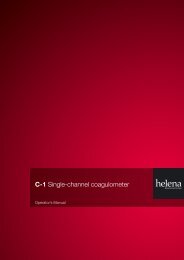
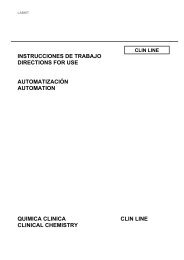
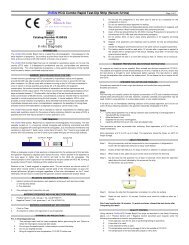
![[APTT-SiL Plus]. - Agentúra Harmony vos](https://img.yumpu.com/50471461/1/184x260/aptt-sil-plus-agentara-harmony-vos.jpg?quality=85)

![[SAS-1 urine analysis]. - Agentúra Harmony vos](https://img.yumpu.com/47529787/1/185x260/sas-1-urine-analysis-agentara-harmony-vos.jpg?quality=85)


![[SAS-MX Acid Hb]. - Agentúra Harmony vos](https://img.yumpu.com/46129828/1/185x260/sas-mx-acid-hb-agentara-harmony-vos.jpg?quality=85)

